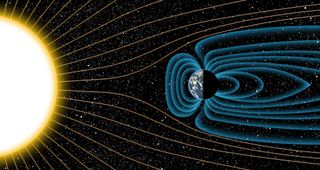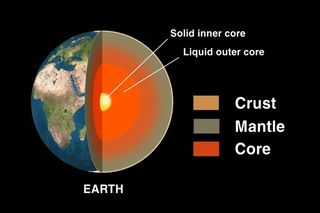
Shields Up! How the Earth Got a Force Field

Paul Sutter is a visiting scholar at the Ohio State University's Center for Cosmology and Astro-Particle Physics (CCAPP). Sutter is also host of the podcasts Ask a Spaceman and RealSpace, and the YouTube series Space In Your Face. He contributed this article to Space.com's Expert Voices: Op-Ed & Insights.
Earth has a force field. A real, literal, honest-to-goodness force field. A field that projects invisibly out into space, protecting us and our precious atmosphere from the dangers of the cosmos. Without it, we might just have ended up like Mars: a wasteland, a failed chance at life.
Oh, yeah, and it makes your compass wiggle.
The planet's invisible superpower
It's the magnetic field. Wrapped in its warm embrace, the Earth can withstand the incessant onslaught of the solar wind and the cosmic rays (streams of high-energy particles flooding through the universe). Upon encountering the Earth with nefarious intent, they are deflected, their paths twisted and bent. The Earth's force field guides them like cars on a highway with no exit ramps, dumping them at the Arctic and Antarctic poles. (Watch: How the Earth's Force Field Works.)

The aurorae are the magnetic field's bonus gift to us humans. Not only does the field protect us, it gives us a light show, too. Take away the field, and you have to take away the light show. And our air — because all those high-energy particles can ping-ping-ping away all our lovely molecules of atmosphere. And we'll all probably get more cancer, because those same high-energy particles can ping-ping-ping away at our DNA, too. [Aurora Photos: Amazing Northern Lights Display from Solar Storms ]
The good news is that the Earth's magnetic field isn't going away soon. But "soon" here can mean as little as a few hundred years. It's not exactly static: it flips around, it weakens in spots, and sometimes it goes away entirely. The northern pole is currently wandering across Canada on an expedition to Siberia, and its overall strength has been steadily decreasing relatively recently.
That's because even though it looks like the field of a gigantic bar magnet — imagine a giant red "N" and a giant silver "S" buried in the Earth's mantle — it's not. It's generated from a roiling, tumbling, swirling, hot mess of a process deep in the Earth's core: a dynamo.
Get the Space.com Newsletter
Breaking space news, the latest updates on rocket launches, skywatching events and more!
Dynamic dynamo
The short definition of a dynamo is this: it's a thing that makes magnetic fields. The long definition is pretty long. After all, this is an active area of scientific research. What follows is a an attempt to capture it.
It turns out it's pretty easy for nature to make a magnetic dynamo, and there are many different kinds. For the type that makes the Earth's field, all you need are:
- A large amount of conducting material.
- Rotation that is faster near the middle than at the edges.
- Some source of agitation.
I'm pretty sure you could arrange all that at a local hardware store. If you can't, then you're not even trying.
So here's the story, at least as it's thought to apply to the Earth. The core is really metal: iron, nickel — the works. Metals conduct electricity. Check.
The Earth is also spinning. You may have noticed. But because the solid inner core is surrounded by the liquid outer core, and the mantle isn't quite a solid, the inner bits rotate faster than the outer bits. Check.

Finally, the core of our planet is really, really hot. The outside is … less so. Like an inside-to-out boiling pot of water, this heat difference creates convection currents. Made of liquid metal. Look, just go with it. And because of the Coriolis force, the rotation of the Earth twists up the convection currents, like a magma hurricane. Like I said, just go with it. Hurricanes are rather agitating: the last check mark is in place. The innards of our planet have all the ingredients to create a magnetic dynamo.
Conducting metals in the core move around, creating a weak magnetic field. Due to the convection and twisting, that field gets folded and re-folded and enforced and reinforced, like doubling-up a weak rubber band to make it stronger. This changing magnetic field influences the motion of the conducting material, which ends up making even more magnetic field. (Learn more about the Earth's dynamo in this video.)
The Earth's core is just having too much fun — it can't help but keep cranking out magnetic fields.
Not only do dynamos create magnetic fields, but also they sustain them. As long as a source of energy remains, the force field stays up. That's how Earth has managed to keep its protective shield for billions of years. But what's the source of that energy?
Enter the Inferno
The solution is heat: As long as the core stays hot, the dynamo can keep being … uh, dynamic. The Earth gets its internal heat from a few things, like the crushing pressure of its own gravity, but also from all the radioactive elements it was born with. As the Fukushima nuclear tragedy ably demonstrated, radioactive things are hot. The core has lots of radioactive junk floating around. Ergo, it's hot.

What about the other planets? We can easily see what happens when we take one of the essential dynamo ingredients away. Mercury is small and has a slow rotation: weak dynamo, weak field. Venus has a slow rotation too, but its lack of plate tectonics — which, by the way, you can also think of as boiling rock — and its suffocating atmosphere means that there's little temperature difference between the inside and outside. No difference, no convection, no dynamo, no magnetic field. (Watch this video to learn about the magnetic fields of the gas giants.)
Mars? Poor, sad, pathetic Mars. It was once like Earth: hot core, cool crust, rapid rotation. And it, too, started life with a magnetic field. But its small size doomed it: the core cooled off, the dynamo shut down and brought the young magnetic field with it. Lacking a force field, its Earth-like atmosphere was easy pickings for the solar wind and cosmic rays, nibbling at its edges for millennia, withering it away to the insubstantial almost-vacuum it is today.
So the next time you take a nice deep breath of delicious N2 and O2, kiss your compass, salute the magnetic field, and thank the dynamo.
Learn more by listening to the episode "How do planets get magnetic fields?" on the Ask a Spaceman podcast, available on iTunes and on the Web at http://www.askaspaceman.com. Thanks to Mike Serens for the question that led to this piece! Ask your own question on Twitter using #AskASpaceman or by following Paul @PaulMattSutter and facebook.com/PaulMattSutter.
Follow all of the Expert Voices issues and debates — and become part of the discussion — on Facebook, Twitter and Google+. The views expressed are those of the author and do not necessarily reflect the views of the publisher. This version of the article was originally published on Space.com.
Join our Space Forums to keep talking space on the latest missions, night sky and more! And if you have a news tip, correction or comment, let us know at: community@space.com.

Paul M. Sutter is an astrophysicist at SUNY Stony Brook and the Flatiron Institute in New York City. Paul received his PhD in Physics from the University of Illinois at Urbana-Champaign in 2011, and spent three years at the Paris Institute of Astrophysics, followed by a research fellowship in Trieste, Italy, His research focuses on many diverse topics, from the emptiest regions of the universe to the earliest moments of the Big Bang to the hunt for the first stars. As an "Agent to the Stars," Paul has passionately engaged the public in science outreach for several years. He is the host of the popular "Ask a Spaceman!" podcast, author of "Your Place in the Universe" and "How to Die in Space" and he frequently appears on TV — including on The Weather Channel, for which he serves as Official Space Specialist.
